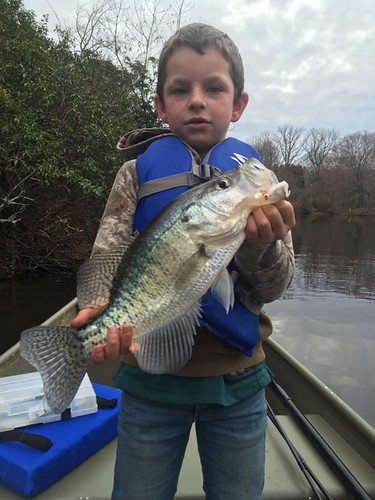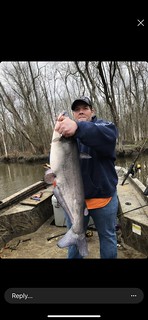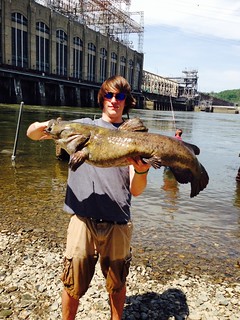Maryland Fishing Report – March 18

Michael Novak Jr. caught this beautiful crappie recently while fishing with his dad. Photo by Michael Novak
We face extraordinary times and everyone must make decisions regarding the safety of ourselves and those we love. Given Maryland’s current State of Emergency, the Maryland Department of Natural Resources has made adjustments as well.
After careful consideration, the department decided to suspend spring trout stocking to protect the health and safety of our state employees and also the public and angling community. We need to avoid a situation that encourages anglers to gather near stocked locations. The department may also cancel or postpone fishing-related events this spring, including youth fishing rodeos and fishing tournaments due to the Executive Order prohibiting gatherings of 50 people or more.
But that doesn’t mean you can’t go fishing. In fact, the department has already stocked 82,700 brown, golden, and rainbow trout across the state. While it is unknown at this time when trout stocking will resume, we do encourage anglers to safely take advantage of incredible fishing opportunities Maryland has to offer.
For those looking for ways to occupy children stuck at home, consider a peaceful fishing adventure — obviously taking care to keep your proper social distance from others and avoid unnecessary exposure.
Please keep an eye on the department’s website and social media for updates, and we will resume regular operations once we are safely able.
Be safe, be responsible, be kind to each other, and we will get through these trying times together.
Forecast Summary: March 18-24:
Friday is the first day of Spring and signs are everywhere. Blooming daffodils, forsythia bushes and pear trees are all indicators that Chesapeake Bay water temperatures are on the rise. Bay mainstem surface waters and rivers have risen to the upper 40s and will continue to rise through the next week. Warmest waters continue to be found in the bottom quarter of the water column near the Virginia state line. However, smaller, dark-bottom streams and downwind areas on a sunny day will warm faster, often holding water temperatures in the low to mid-50s.
These typical March conditions will continue to warm Maryland waters for gamefish such as white perch preparing to spawn in the next several weeks. They will spawn in the lower salinity waters — up to 4 ppt — when water temperatures are between 50 degrees and 60 degrees. In addition, shad will continue to make their way up the bay towards their spawning areas in many of the larger rivers. The first hickory shad are now present on the Potomac River at Fletcher’s Boathouse in D.C., with water temperatures now at 55 degrees. In addition, in the main bay, there are still slightly warmer bottom waters so anglers may want to scan these areas for other gamefish.
The Maryland portion of the bay continues to have suitable oxygen conditions from surface to bottom. Bay surface salinities are normal for this time of year. Expect reduced water clarity in the upper bay from the Aberdeen and Sassafras rivers to Swan Point, and on the Potomac River downstream to near the Route 301 Bridge. Expect normal flows to the rivers and streams entering Maryland’s portion of the Bay. There will be above average tidal currents conditions from Friday through Tuesday as a result of the new moon March 24.
For more detailed and up-to-date fishing conditions in your area of the bay, be sure to check out Eyes on the Bay’s Click Before You Cast.
Get regular updates on Maryland’s waters sent to your inbox with our Eyes on the Bay newsletter. Sign up online.
There is plenty of fun fishing action at the Conowingo Dam pool for a mix of large flathead and blue catfish. The releases from the dam have been minimal recently due to the lack of rainfall in the Susquehanna watershed. Anglers are wearing waders to get closer to the dam pool and casting cut bait and heavy swimshads with stout spinning tackle. Early in the morning, there has also been some catch-and-release action with striped bass on topwater lures.
A little farther downriver there is a mix of small to medium-sized flathead catfish, along with channel catfish and blue catfish. Most anglers fishing for them are using fresh cut bait on a bottom rig in some of the deeper holes between the I-95 Bridge and the Railroad Bridge.
Yellow perch are still being caught near the Perryville area and the Northeast River. The action has subsided quite a bit but there are still pre-spawn and post-spawn yellow perch being caught. The most popular way to fish for them has been using live minnows fished near the bottom in the more open waters. White perch will be arriving on the scene soon, as water temperatures are about 47 degrees and rising. When the water temperatures climb to the mid-50s, the white perch will move into the area.
There is still some yellow perch action in the upper Bush and Magothy rivers on the western side of the bay, but it is falling off quickly. Those who are fishing with pieces of bloodworm and grass shrimp are catching the first white perch entering the river systems. The upper Chester River is seeing the same situation with post-spawn yellow perch leaving and pre-spawn white perch arriving.
Water temperatures in the upper bay are holding around the mid-40s, still a little chilly for school-sized striped bass. There has been a little catch-and-release action with striped bass near the Bay Bridge and Scott Key Bridge piers. Most are jigging near the pier bases. Striped bass regulations for the Spring Trophy Season can be viewed online.

Scott Green holds up a big Blue Catfish he caught recently in the Nanticoke River on cut white perch. Photo courtesy of Scott Green
The upper Choptank and Tuckahoe rivers have been receiving a lot of attention from anglers pursuing yellow perch. Those spawning runs are just about over now, but there are opportunities to catch yellow perch as they descend the rivers headed away from the spawning areas. Small minnows lip-hooked to a small shad dart or on a simple bottom rig work very well for these fish as they move through the channels.
Fish with grass shrimp on a shad dart or bottom rig and you very well may catch some white perch and enjoy a little catch-and-release action with river herring and hickory shad. They are moving up the Choptank and Tuckahoe and can be found above Denton to the Greensboro area, and may reach the Red Bridges area by the weekend as the weather forecast calls for some very warm temperatures. A bottom rig baited with pieces of bloodworm is a popular way to fish for them, when taking it easy with a good seat and forked stick along a riverbank or leisurely fishing out of a small boat.
Fishing for northern snakeheads is shifting into high gear this week as balmy and sunny days warm up area waters, enticing them to be more active. Casting white or other color swimbaits is a proven tactic this time of the year, and chatterbaits are working well also. Fishing a large minnow trailing behind a popping cork or bobber is perhaps the most tried-and-true method before grass beds appear and the northern snakeheads are in more open water.
The tidal waters in lower Dorchester County are one of the best places in Maryland to fish for northern snakeheads. The populations are exploding, offering anglers plenty of opportunities to catch a mess of them and also participate in conservation methods to try and control their numbers. They make excellent eating and freeze well. My favorite way to prepare them is to cut the fillets in 3-inch strips, dip them in egg batter, dredge in panko and let them sit in the refrigerator for about 3 hours before frying them in hot oil. If you wish to skip the oil, you can brown them in butter and finish cooking them in a toaster oven.
For blue catfish, the Nanticoke River in the Sharptown area to the mouth of the Marshyhope Creek is the best spot on the Eastern Shore. Anglers there are catching coolers full of them, with most in the 4- to eight 8-pound size range, perfect for eating. Fresh cut bait, often gizzard shad, is the most popular. White perch are moving through the area, and they also make good fresh cut bait.
There is some catch-and-release jigging action at the Calvert Cliffs Power Plant warm water discharge this week, mostly for smaller striped bass. Surface water temperatures in the middle bay region are running about 47 degrees, still a bit chilly for striped bass. The striped bass are moving up the bay and entering the spawning rivers, getting ready for the spawn in late March and early April. There has been some trolling action for larger striped bass but it has been described as a very slow pick with only one or two fish caught and released in a day’s outing.
Fishing for blue catfish is taking center stage this week for those fishing the tidal waters of the Potomac, Patuxent, and Nanticoke rivers. Blue catfish populations have been increasing dramatically in recent years. A recent report about a commercial haul seining operation in the tidal Potomac said it’s not unusual for them to catch 20,000 pounds of blue catfish in a single haul, and taking two days to unload it. Recently they caught about 250,000 pounds in a single haul, which took four days to transport the fish to market. Anglers need not worry — there are still plenty of blue catfish to catch, so give it a try and help control this invasive catfish.
Fresh cut bait on a simple bottom rig is the standard way to fish for blue catfish that are under 8 pounds, which often make for the best eating. The fillets are mild tasting and they freeze well. Those looking for trophy sized blue cats usually use live bait and fish the deepest channel areas. On the Potomac, Fort Washington Marina offers a good boat ramp at a nominal cost.
White perch are moving into the upper regions of the tidal rivers and are providing fun and exciting fishing. They are now moving into the shallower and more confined areas of the tidal rivers and creeks, providing for fun light tackle fishing. Small shad darts with a piece of minnow or grass shrimp on it is perhaps the most popular way to fish, casting slightly upstream and bouncing the shad dart as it swings in the current. The white perch tend to move in waves of various sizes; often you’ll be catching small perch one after another, then large ones for a minute or two, then small ones again.
Northern snakeheads are providing some fun fishing in the tidal rivers and creeks of the lower Eastern Shore and the tidal Potomac. Casting chatterbaits and light-color swimshads are a good way to cover water when looking for these fish. Large minnows fished under a bobber or trailing a popping cork is another good way to catch them this time of the year.
A few anglers are trying their hand at catch-and-release fishing for the large, pre-spawn striped bass moving up the bay. The best success seems to be coming from lures trolled behind planer boards, since the fish tend to be up on top in the warmer water. Some light-tackle anglers are finding school-sized striped bass holding along channel edges and taking jigs.
As mentioned previously, the department decided to suspend spring trout stocking to protect the health and safety of our state employees and also the public and angling community. We need to avoid a situation that encourages anglers to gather near stocked locations.

Mike Tarud holds up a beautiful 7-pound, 12-ounce largemouth bass he caught and released recently in the tidal portion of the Gunpowder River. Photo by Rob Hennlein
There is still plenty of enjoyable trout fish to be had. To date, the department has stocked 82,700 brown, golden and rainbow across the state. There are still trout to be found in the many put-and-take areas which are 0 Closure. The Closure 1 areas remained closed until 5:30 a.m. on March 28. The catch-and release trout management areas are open and hold generous numbers of trout to entertain any fisherman. The fly-fishing-only trout management waters hold special promise for enjoyment. Fishing with nymphs or streamers this time of year is often a good bet.
All waters in the state are running very low due to the lack of rain and snow. The upper Potomac River is no exception; flow rates are down and there are a lot of exposed boulders in some areas. When fishing for smallmouth bass, casting small crankbaits near emerging grass and ledges is a good idea in shallower areas; use tubes, grubs, and jigs in the deeper portions of the river.Fishing minnows can also be a great option when fishing these deeper waters, which is where walleye tend to be holding.
Largemouth bass are responding to warmer water temperatures by becoming more active and moving into shallower waters. During the morning hours, the largemouth bass tend to hold in deeper waters often near structure. Silver buddies, grubs and various soft plastics are a good choice when fishing these deeper waters.
As the day progresses and the sun begins to warm surface waters, shallow-running crankbaits such as Rat-L-Traps are a great idea in the transition zones between drop-offs and shallower waters. The slightly shallower areas are good places to work spinnerbaits and cover a lot of water. Any emerging grass is an excellent place to work for largemouth bass holding nearby. When fishing tidal waters, always be ready for northern snakeheads that are holding in the same areas.
Spring is a wonderful time of the year to fish for crappie as they school up in about 5-6 feet of water near any kind of structure they can find. They can be found in many of our tidal waters, small farm ponds, and reservoirs throughout Maryland. Using small minnows or marabou jigs under a slip bobber are two of the best ways to catch them. In tidal waters, marina piers, bridge piers, fallen treetops, and submerged rubble are good places to look for them. Fallen treetops and sunken structure are places to target in nontidal waters.

Darcia Ward holds up her personal best tautog for the camera that she tagged and released back into the ocean. Photo by Monty Hawkins
Fishing for tautog still dominates the fishing scene in the Ocean City area, and there has been enough tautog activity around the Ocean City Inlet to entertain anglers wishing to enjoy the balmy weather. The charter and party boats heading to the offshore wreck and reef sites continue to enjoy excellent fishing for large tautog. Due to these extraordinary times that encourage social distancing, make sure to contact boat captains to see if they are still taking anglers out and of course use your best judgment to protect your health.
“No life is so happy and so pleasant as the life of the well-govern’d angler.“–Izaak Walton
Maryland Fishing Report is written and compiled by Keith Lockwood, Maryland Department of Natural Resources fisheries biologist.
Click Before You Cast is written by Tidewater Ecosystem Assessment Director Tom Parham.
This report is now available on your Amazon Echo device — just ask Alexa to “open Maryland Fishing Report.”



 1-888-373-7888
1-888-373-7888 233733
233733